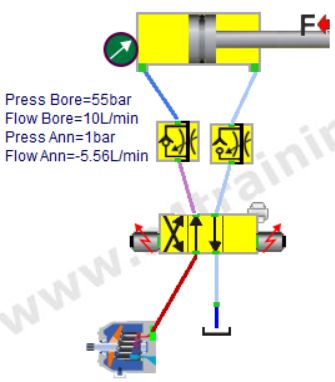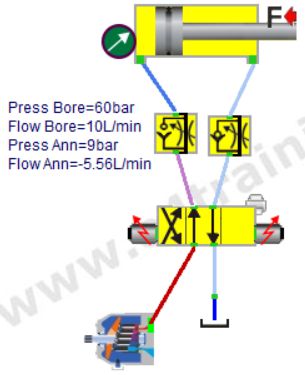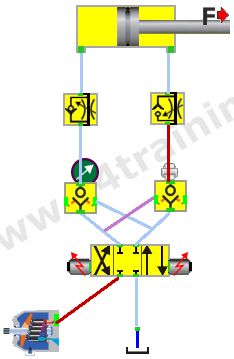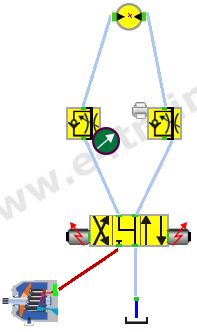Topics and outcomes
Expected outcomes: Understand the different types of flow control valve with examples of the main performance issues and how they are used.
Level: 2-4 Novice to improver
Topic covered: Fixed and variable orifices
- Pressure compensated flow control
- Meter-in flow control
- Meter-out flow control
- Pressure intensification
Variable orifice performance

 Question: What happens when the orifice size is changed from 10 to 6mm?
Question: What happens when the orifice size is changed from 10 to 6mm?
 Experiment: Open circuit Flow/1_Variable Orifice Flow Control Valve. Move the test gauge over the orifice. Click on the variable orifice symbol. Change the restriction diameter from 10 to 6mm.
Experiment: Open circuit Flow/1_Variable Orifice Flow Control Valve. Move the test gauge over the orifice. Click on the variable orifice symbol. Change the restriction diameter from 10 to 6mm.
 Question: What happens when the orifice size is changed from 6 to 4mm?
Question: What happens when the orifice size is changed from 6 to 4mm?
 Experiment: Click on the variable orifice symbol and change the restriction diameter to 3mm.
Experiment: Click on the variable orifice symbol and change the restriction diameter to 3mm.
 Question: Is the flow rate dependent on the pump flow?
Question: Is the flow rate dependent on the pump flow?
 Experiment: Drag the printer icon over the flow control valve. Reduce the orifice size in 1mm steps from 10 to 2mm pressing the large printer icon each time. Copy the results and plot the graph in a spreadsheet.
Experiment: Drag the printer icon over the flow control valve. Reduce the orifice size in 1mm steps from 10 to 2mm pressing the large printer icon each time. Copy the results and plot the graph in a spreadsheet.
 Question: Is the flow rate sensitive to the load on the system?
Question: Is the flow rate sensitive to the load on the system?
 Experiment: Reload circuit Flow/1_Variable Orifice Flow Control Valve. Click on the motor symbol. Change the load torque and observe the effect on the motor speed e.g. flow rate. Repeat with 6 and 4mm orifice.
Experiment: Reload circuit Flow/1_Variable Orifice Flow Control Valve. Click on the motor symbol. Change the load torque and observe the effect on the motor speed e.g. flow rate. Repeat with 6 and 4mm orifice.
 Question: What difference does a meter-in flow control valve make?
Question: What difference does a meter-in flow control valve make?
 Experiment: Click on the FCV symbol and select the meter-in option from the drop down box. Repeat the above test to identify any differences.
Experiment: Click on the FCV symbol and select the meter-in option from the drop down box. Repeat the above test to identify any differences.
 Question: What difference does a meter-out flow control valve make?
Question: What difference does a meter-out flow control valve make?
 Experiment: Click on the FCV symbol and select the meter-out option from the drop-down box. Repeat the above test but also change the nominal size of the valve to the same size as the restrictor.
Experiment: Click on the FCV symbol and select the meter-out option from the drop-down box. Repeat the above test but also change the nominal size of the valve to the same size as the restrictor.
Pressure compensated flow control performance

 Question: What is the difference between setting a pressure compensated valve compared to a variable orifice?
Question: What is the difference between setting a pressure compensated valve compared to a variable orifice?
 Experiment: Open circuit Flow/2_Pressure Compensated Flow Control. Move the test gauge over the FCV. Click on the variable orifice symbol. Compare the settings to the variable orifice.
Experiment: Open circuit Flow/2_Pressure Compensated Flow Control. Move the test gauge over the FCV. Click on the variable orifice symbol. Compare the settings to the variable orifice.
 Question: What happens when the flow rate is changed from 100 to 60L/min?
Question: What happens when the flow rate is changed from 100 to 60L/min?
 Experiment: Open circuit Flow/2_Pressure Compensated Flow Control. Move the test gauge over the FCV. Click on the variable orifice symbol. Change the flow rate from 100 to 60L/min.
Experiment: Open circuit Flow/2_Pressure Compensated Flow Control. Move the test gauge over the FCV. Click on the variable orifice symbol. Change the flow rate from 100 to 60L/min.
 Question: Is the pressure compensated FCV more energy efficient than the variable orifice FCV
Question: Is the pressure compensated FCV more energy efficient than the variable orifice FCV
 Experiment: Compare input power required for the PC and orifice FCVs under the same operating conditions
Experiment: Compare input power required for the PC and orifice FCVs under the same operating conditions
 Question: Is the flow rate dependent on the pump flow?
Question: Is the flow rate dependent on the pump flow?
 Experiment: Drag the printer icon over the flow control valve. Reduce the flow rate from 100 to 10L/min, pressing the large printer icon at each step. Copy the results and plot the graph in a spreadsheet.
Experiment: Drag the printer icon over the flow control valve. Reduce the flow rate from 100 to 10L/min, pressing the large printer icon at each step. Copy the results and plot the graph in a spreadsheet.
 Question: Is the flow rate sensitive to the load on the system?
Question: Is the flow rate sensitive to the load on the system?
 Experiment: Click on the motor symbol. Change the load torque and observe the effect on the motor speed e.g. flow rate. Repeat with different FCV flow settings.
Experiment: Click on the motor symbol. Change the load torque and observe the effect on the motor speed e.g. flow rate. Repeat with different FCV flow settings.
Meter-in flow contol valves

 Question: What type of load does this circuit have?
Question: What type of load does this circuit have?
 Experiment: Open circuit Flow/3_Meter-In Flow Control. Click on the cylinder rod. Look at the loads on the cylinder and complete manual calculations to check what the pressures should be.
Experiment: Open circuit Flow/3_Meter-In Flow Control. Click on the cylinder rod. Look at the loads on the cylinder and complete manual calculations to check what the pressures should be.
 Question: Where is the flow rate controlled while extending the cylinder?
Question: Where is the flow rate controlled while extending the cylinder?
 Experiment: extend the cylinder and move the test gauge around the circuit to understand where pressure drop is that controls the flow.
Experiment: extend the cylinder and move the test gauge around the circuit to understand where pressure drop is that controls the flow.
 Question: How is the flow rate controlled while retracting the cylinder?
Question: How is the flow rate controlled while retracting the cylinder?
 Experiment: retract the cylinder and measure the pressures around the circuit. Knowing that hydraulics is a braking technology and we use pressure drops to control movement. Consider how this is achieved while retracting with meter-in controls.
Experiment: retract the cylinder and measure the pressures around the circuit. Knowing that hydraulics is a braking technology and we use pressure drops to control movement. Consider how this is achieved while retracting with meter-in controls.
 Question: Will the same extend and retract speeds require the same size orifice.
Question: Will the same extend and retract speeds require the same size orifice.
 Experiment: Click on the FCV valves to see the restrictor size. Observe the flow rates through the flow control valves.
Experiment: Click on the FCV valves to see the restrictor size. Observe the flow rates through the flow control valves.
Meter-out flow contol valves

 Question: Compare meter-out with meter-in control?
Question: Compare meter-out with meter-in control?
 Experiment: Open circuit Flow/4_Meter-Out Flow Control. Operate the directional valve and compare circuit pressures with those seen using the meter-in circuit.
Experiment: Open circuit Flow/4_Meter-Out Flow Control. Operate the directional valve and compare circuit pressures with those seen using the meter-in circuit.
 Question: Where is the flow rate controlled while extending the cylinder?
Question: Where is the flow rate controlled while extending the cylinder?
 Experiment: Extend the cylinder and move the test gauge around the circuit to understand the location of the pressure drop that controls the flow.
Experiment: Extend the cylinder and move the test gauge around the circuit to understand the location of the pressure drop that controls the flow.
 Question: How is the flow rate controlled while retracting the cylinder?
Question: How is the flow rate controlled while retracting the cylinder?
 Experiment: Retract the cylinder and measure the pressures around the circuit. Knowing that hydraulics is a braking technology and we use pressure drops to control movement. Consider how this is achieved while retracting with meter-out controls.
Experiment: Retract the cylinder and measure the pressures around the circuit. Knowing that hydraulics is a braking technology and we use pressure drops to control movement. Consider how this is achieved while retracting with meter-out controls.
 Question: Approximately what size restrictor is required start slowing the extend speed?
Question: Approximately what size restrictor is required start slowing the extend speed?
 Experiment: Move the test gauge to the cylinder body. Operate the raise solenoid then double click on the cylinder to freeze its movement (but not performance). Restrict the extend side FCV size until the pump flow rate starts to fall. Observe what happens to the pressures as the flow is restricted.
Experiment: Move the test gauge to the cylinder body. Operate the raise solenoid then double click on the cylinder to freeze its movement (but not performance). Restrict the extend side FCV size until the pump flow rate starts to fall. Observe what happens to the pressures as the flow is restricted.
 Question: What parameter causes the annulus pressure to exceed the maximum pump supply presssure?
Question: What parameter causes the annulus pressure to exceed the maximum pump supply presssure?
 Experiment: Modify the physical parameter of the component in the circuit until you isolate what causes the pressure increase.
Experiment: Modify the physical parameter of the component in the circuit until you isolate what causes the pressure increase.
 Question: What other parameters affect the level of annulus intensification pressure and what is the worse case?
Question: What other parameters affect the level of annulus intensification pressure and what is the worse case?
 Experiment: Modify the loads acting on the cylinder and observe how the pressures change. Reduce the loads to zero to note the worse case pressure intensification. Compare this figure with the figure you calculate using the cylinder areas.
Experiment: Modify the loads acting on the cylinder and observe how the pressures change. Reduce the loads to zero to note the worse case pressure intensification. Compare this figure with the figure you calculate using the cylinder areas.
Diagnose the cylinder retract instability

 Question: Diagnose the cylinder retract instability?
Question: Diagnose the cylinder retract instability?
 Experiment: Open Flow/Diagnose 1 FCV POCheck. extend and retract the cylinder. Change different parameters until you remove the judder and understand what causes it.
Experiment: Open Flow/Diagnose 1 FCV POCheck. extend and retract the cylinder. Change different parameters until you remove the judder and understand what causes it.
Experiment with a speed contol motor circuit

 Question: Experiment with a directional control valve and motor circuit
Question: Experiment with a directional control valve and motor circuit
 Experiment: Open Flow/Test 1 Motor FCV. Experiment with different loads, flows, pressure and valve configurations. Use the printer icon and button to take measurements and print out results via a spreadsheet.
Experiment: Open Flow/Test 1 Motor FCV. Experiment with different loads, flows, pressure and valve configurations. Use the printer icon and button to take measurements and print out results via a spreadsheet.
 Question: Record the bore and annulus pressures while extending and retracting the cylinder with different loads
Question: Record the bore and annulus pressures while extending and retracting the cylinder with different loads
 Experiment: Click on the FCV valves to see the restrictor size. Observe the flow rates through the flow control valves.
Experiment: Click on the FCV valves to see the restrictor size. Observe the flow rates through the flow control valves.
 Question: Build and test your own circuits
Question: Build and test your own circuits
 Experiment: Click the spanner icon to build and test your own circuit. Enter the loads and sizes from equipment nearby and compare performance results.
Experiment: Click the spanner icon to build and test your own circuit. Enter the loads and sizes from equipment nearby and compare performance results.